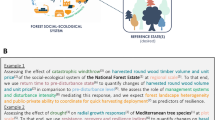Abstract
Context
WUI wildfire disasters are increasing, as fires are pushed by strong winds and drier fuels across landscapes and into communities. Possible disasters make maintaining and restoring landscape-scale fire in fire-adapted ecosystems difficult. Rapid action is needed to reduce building loss in WUI wildfire disasters.
Objectives
In a Colorado study, I used distance-based empirical modeling to refine potential risk of building loss in WUI wildfire disasters to focus risk-reduction efforts.
Methods
New empirical modeling showed 95% of USA building loss in WUI wildfire disasters was within 100 m of wildland vegetation. I used modeling to estimate and map potential relative risk of a WUI wildfire disaster for each of 2,185,953 buildings in Colorado.
Results
High-risk buildings were 241,375 or 11% of total buildings. However, the 20–40 m essential defensible space around these buildings covered only 46,767–114,084 ha. Area within 100 m of wildland vegetation, containing these buildings, covered 475,840 ha or 1.8% of Colorado’s 27 million ha. About 95% of at-risk land within 100 m of wildland vegetation is not federally owned, and WUI wildfire disasters are mostly from fires started on private land.
Conclusions
Treating ≤ 114,084 ha of defensible space could leave the 27 million ha of Colorado with lower WUI wildfire disaster-risk to buildings. High risk of building loss is rarely a federal land-management problem. If the goal is rapid reduction of building loss in WUI wildfire disasters, focus resources on defensible space 20–40 m from WUI buildings within 100 m of wildland vegetation.

Similar content being viewed by others
Data availability
Data from the analysis are available from the Dryad depository at: https://datadryad.org/stash/dataset/doi:10.5061%2Fdryad.kd51c5b7s.
References
Ager AA, Day MA, Alcasena FJ, Evers CR, Short KC, Grenfell I (2021) Predicting paradise: modeling future wildfire disasters in the western US. Sci Total Environ 784:147057
Alexandre PM, Stewart SI, Keuler NS, Clayton MK, Mockrin MH, Bar-Massada A, Syphard AD, Radeloff VC (2016) Factors related to building loss due to wildfires in the conterminous United States. Ecol Appl 26:2323–2338
Baker WL (2009) Fire ecology in Rocky Mountain landscapes. Island Press, Washington
Bar-Massada A, Stewart SI, Hammer RB, Mockrin MH, Radeloff VC (2013) Using structure locations as a basis for mapping the wildland urban interface. J Environ Manag 128:540–547
Caggiano MD, Hawbaker TJ, Gannon BJ, Hoffman CM (2020) Building loss in WUI disasters: evaluating the core components of the wildland-urban interface definition. Fire 3:73
Chen K, McAneney J (2004) Quantifying bushfire penetration into urban areas in Australia. Geophys Res Lett 31:L12212
Cohen JD (2000) Preventing disaster: home ignitability in the wildland-urban interface. J For 98(3):15–21
Downing WM, Dunn CJ, Thompson MP, Caggiano MC, Short KC (2022) Human ignitions on private lands drive USFS cross-boundary wildfire transmission and community impacts in the western US. Sci Rep 12:2624
Haas JR, Calkin DE, Thompson MP (2015) Wildfire risk transmission in the Colorado Front Range, USA. Risk Anal 35:226–240
Maranghides A and Mell W (2013) Framework for addressing the national wildland urban interface fire problem–determining fire and ember exposure zones using a WUI hazard scale. U.S. Department of Commerce, National Institute of Standards and Technology, Seattle, WA, Technical Note 1748, p 25
Parks SA, Abatzoglou JT (2020) Warmer and drier fire seasons contribute to increases in area burned at high severity in western US forests from 1985 to 2017. Geophys Res Lett 47:e2020GLO89858
Platt RV, Schoennagel T, Veblen TT, Sherriff RL (2011) Modeling wildfire potential in residential parcels: a case study of the north-central Colorado Front Range. Landsc Urban Plan 102:117–126
Radeloff VC, Hammer RB, Stewart SI, Fried JS, Holcomb SS, McKeefry JF (2005) The wildland-urban interface in the United States. Ecol Appl 15:799–805
Scott JH, Thompson MP, and Calkin DE (2013) A wildfire risk assessment framework for land and resource management. USDA Forest Service General Technical Report RMRS-GTR-315, Rocky Mountain Research Station, Fort Collins, CO
Syphard AD, Keeley JE (2019) Factors associated with structure loss in the 2013–2018 California wildfires. Fire 2:49
Syphard AD, Keeley JE, Massada AB, Brennan TJ, Radeloff VC (2012) Housing arrangement and location determine the likelihood of housing loss due to wildfire. PLoS ONE 7:e33954
Syphard A, Brennan TJ, Keeley JE (2014) The role of defensible space for residential structure protection during wildfires. Int J Wildland Fire 23:1165–1175
Theobald DM, Romme WH (2007) Expansion of the US wildland-urban interface. Landsc Urban Plan 83:340–354
Acknowledgements
I appreciate very helpful comments by Dr. Michael Caggiano on earlier drafts of this manuscript, constructive and insightful comments and suggestions by the editor and peer reviewers, and feedback from members of working groups in southwestern Colorado.
Funding
The authors received no funding.
Author information
Authors and Affiliations
Contributions
WB wrote the manuscript, prepared the figures, and reviewed the manuscript.
Corresponding author
Ethics declarations
Competing interest
The authors declare no competing interests.
Additional information
Publisher's Note
Springer Nature remains neutral with regard to jurisdictional claims in published maps and institutional affiliations.
Rights and permissions
Springer Nature or its licensor holds exclusive rights to this article under a publishing agreement with the author(s) or other rightsholder(s); author self-archiving of the accepted manuscript version of this article is solely governed by the terms of such publishing agreement and applicable law.
About this article
Cite this article
Baker, W.L. Defensible-space treatment of < 114,000 ha 40 m from high-risk buildings near wildland vegetation could reduce loss in WUI wildfire disasters across Colorado’s 27 million ha. Landsc Ecol 37, 2967–2976 (2022). https://doi.org/10.1007/s10980-022-01539-0
Received:
Accepted:
Published:
Issue Date:
DOI: https://doi.org/10.1007/s10980-022-01539-0




